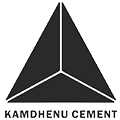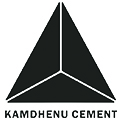In construction, cement and concrete are often mistaken for the same thing. This misunderstanding can lead to costly errors, from incorrect material orders to structural weaknesses. At Kamdhenu Cement, we believe clarity drives quality. Cement is the binder; concrete is the finished material that builds our world.
Understanding this difference between concrete and cement is fundamental for engineers, builders, and homeowners alike. In this blog, let’s settle the concrete vs cement debate once and for all.
What Is Cement? (The “Glue” of Construction)
Think of cement as construction’s ultimate bonding agent. It starts as limestone and clay baked at scorching temperatures (around 1,450°C!). This process creates marble-sized clinker nodules, which are ground into that familiar gray powder.
Here’s what makes cement special:
- It’s a reactor: When water hits cement powder, a chemical dance called hydration begins.
- It transforms: Within hours, it hardens from paste to rock-like strength.
- It’s never solo: You’d never build a wall with just cement – it’s always part of a team.
Kamdhenu Cement produces this critical binder that holds the building world together – literally. Our precise chemistry ensures consistent quality in every bag.
What is Concrete: The Building Material
Now, meet concrete – the most used human-made material on Earth after water. If cement is flour, concrete is the cake. Here’s the recipe:
- Cement: 10-15% (The “glue”)
- Water: Activates the cement
- Aggregates: 60-75% (Sand + Gravel/Crushed Stone)
- Air: Tiny bubbles for durability
When mixed, magic happens:
- Cement and water form a paste that coats every grain of sand and stone.
- Through hydration, this paste hardens into calcium silicate hydrate – a crystal matrix tougher than natural rock.
- Aggregates provide bulk and strength, reducing cost and shrinkage.
That’s why concrete and cement work together: one enables the other. A Kamdhenu-supported slab can last a century; cement alone would crumble in weeks.
Cement vs Concrete: The Key Differences
| Feature | Cement | Concrete |
| What it is | Fine gray powder (binder) | Composite material (cement + aggregates + water) |
| Strength | Weak alone (like chalk) | Extremely strong (holds up skyscrapers) |
| Durability | Cracks easily if unsupported | Lasts 50-100+ years when properly cured |
| Primary Role | Ingredient | Finished construction material |
| Used Alone? | Never | Yes – for slabs, columns, roads |
| Examples | Mortar, grout, tile adhesive | Foundations, dams, bridges, pavements |
Why Your Concrete Mix Recipe Matters
Getting the difference between concrete and cement is step one. Step two? Mastering the mix. Here’s what pros watch:
1. Cement Content:
- Too little: Weak, porous concrete
- Too much: Expensive, prone to cracking
- Kamdhenu tip: 350-400 kg cement per m³ for standard slabs
2. Water-Cement Ratio:
- Ideal range: 0.4 to 0.6
- Excess water = Weak concrete (dilutes the binder)
3. Aggregate Quality:
- Clean, well-graded sand/stone improves strength
- Contaminants (dirt, clay) sabotage bonding
4. Curing Time:
- Concrete gains strength for 28+ days
- Premature drying = Brittle results
Environmental & Sustainability Insights of Cement and Concrete
Cement’s Carbon Challenge:
Producing 1 ton of cement releases ~900 kg CO₂. Why?
- Burning fossil fuels to heat kilns
- Chemical breakdown of limestone
Concrete’s Eco-Advantages:
- Long Life: A well-built concrete structure lasts generations
- Thermal Mass: Regulates building temperatures (cuts AC bills)
- Recyclability: Crushed concrete makes new aggregate
- Carbon Absorption: Over decades, concrete reabsorbs 20-30% of the process CO₂
Kamdhenu Cement leads with solutions:
- Blended Cements: Using fly ash/slag cuts CO₂ by 30%
- Efficient Kilns: Lower-temperature processing
- Stronger Mixes: Less cement needed per cubic meter
Why Choose Kamdhenu Cement?
When you choose Kamdhenu Cement, you’re not just buying powder – you’re investing in:
- Consistent Reactivity: Predictable setting times for smoother workability
b. Optimal Strength Gain: Higher 28-day compressive strength
c. Durability Boost: Resists corrosion from moisture/salts
d. Sustainable Formulas: Lower-carbon options without sacrificing performance
Our cement is engineered to perform in India’s diverse climates – from humid coasts to freezing mountains.
Conclusion: Building Knowledge, Then Buildings
Now you know:
- Cement = Binder powder
- Concrete = Cement + Water + Aggregates
- Kamdhenu Cement = The quality foundation for superior concrete
Whether you’re pouring a garden path or a high-rise, understanding this difference between concrete and cement ensures:
- Safer structures
- Cost-effective builds
- Longer-lasting results
Build smarter with Kamdhenu Cement – where every grain of cement powers progress.
Have a project? Consult our technical team for mix design guidance.
FAQs:-
1. What is the main difference between concrete and cement?
Cement is a fine binding powder. Concrete is a solid material made by mixing cement with water, sand, and gravel.
2. Does cement turn into concrete?
Cement turns into concrete only when combined. Cement with water forms a paste, and adding sand to it and gravel creates concrete.
3. Which is stronger between cement or concrete?
Concrete is stronger. Cement alone cracks under pressure. Concrete supports heavy structures.
4. Which lasts longer, concrete or cement?
Concrete lasts longer than cement, as cement lacks structural strength and breaks down quickly.
5. Cement Vs. Concrete: Key differences & uses?
Cement is used in mortars/grouts as glue, Whereas Concrete is used for foundations, roads, and buildings.


